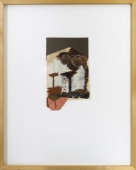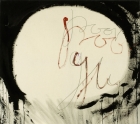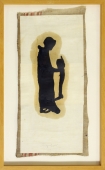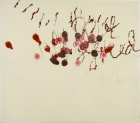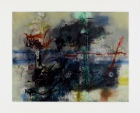
Artist | Bill Viola (1951 - 2024)
Alias: Bill Viola [William Viola]
https://www.artist-info.com/artist/Bill-Viola
Biography
Biography
born in 1951
About the work (english / deutsch) The Stopping Mind / The Greeting
About the work (english / deutsch) The Stopping Mind / The Greeting
Many people in Frankfurt are acquainted with Bill Viola thanks to his video & sound installation The Stopping Mind (1989-91), which he conceived and created for the opening of the Museum für Modeme Kunst. His only permanent installation world-wide, it continues to be one of the most important works in the Frankfurt collection. Since about 1976 he has increasingly concentrated on the subjektive perception of the visible outer as well as invisible inner linking of the world, on relationships between humans and nature, humans and culture, humans and civilization, as well as on questions as to the reality of life and death, of a possible life before birth and alter death. By means of video, Viola has developed a complex metaphorical language with which he tracks down the structures of being or existence and makes us aware of them. Using a video camera, he has developed a series of technological modes of expression based on relativizing the temporal sequence of an act, that is to say by accelerating and slowing real time and deliberately changing spatial contexts, by superimposing different realms or dissolving one location into different realms. It is his goal to show that the states of the human intellect or consciousness are a concentrically structured context composed of many mental and emotional moments simultaneously and do not occur in the form of a linear sequence. Viola's artworks draw their contemplative power primarily from the ideas of Zen Buddhism, from the belief both that every object and creature in each microcosm or macrocosm of the world shares fundamentally in the essence of the world as a whole and that this wholeness is consequently discernible in each and every component
In 1991, Viola conceived his video & sound installation entitled The Stopping Mind for a square showroom in the MMK in Frankfurt. In the room completely painted black, so that it could be termed a 'Black Box' (the metaphor for intellectual space per se) - Viola has hung four identical, large projection screens at a certain distance from the outer walls. Their lateral surfaces circumscribe a cube open at the comers. Through the canvasses, a room arises within the room, so that on entering the installation you see the inside and outside as two parts of a whole and simultaneously become aware of your own function as part of the work. Four large-image projectors mounted on the ceiling in the middle of the canvas frames cast stationary or moving video images onto the respectively opposite screen for a couple of seconds simultaneously; the screens are therefore always mutually linked by motifs and contents. On entering the room, you first encounter calm. This is interrupted initially only by a soft whisper, which, the further you advance into the room, becomes ever louder and ultimately, when you stand exactly in the center of the room, becomes recognizable as articulated language spoken in a whisper. The voice of the artist monotonously recites an English text without stopping, a text which describes the gradual meditative immersion of his mind into his own person. The voice reflects the exemplary interior monologue of a person who, by tuming his back on the visible world, on visually experienced reality, gradually progresses into a world of an inner reality, into the domains of truth and knowledge. The artwork describes a state of being in which there are no feelings, no sounds, no sensations, in which darkness and quiet prevail, in which the mind detaches itself from the everyday world and from the body, merging with the wholeness that is the 'world'.
Suddenly and without prior warning, the stationary pictures are caught up in furious motion, accompanied by rumbling, loud noises, Making a great din, simultaneous sequences of images with motifs taken from the visible, audible and perceptible reality of everyday life storm towards anyone standing in the center of the room. The usual response is, partly out of a slight sense of fear, partly out of interest in the processes, to endeavor to find a new point of orientation among the sonorous pictures in order to grasp the motifs and situations more concretely. Just as suddenly, the moving images freeze into stills, the sounds echo a while in the room and in your ears, and then everything goes completely sillent. Only now do you notice that the whispering voice in the center of the room was overlaid with the sound of the moving images; now, it once more becomes gradually audible. The reality of the outer world disappears for a short time again behind the reality of the narrator's inner world.
If you spend several minutes in the Viola room, then you learn more about the origin of the pictures. In total Viola filmed 21 different locations, different places in the outdoors and in the city. He often moved the video camera sharply while at the same time recording sounds from the surroundings and the sound of the microphone brushing objects, leaves or branches. Finaily he mixed these for the final version of the video with noises of the whistling or whispering wind or the sound of cars on a highway. The camera repeatedly changes its distance from the motifs filmed, often rendering them indistinct owing to sharp movements, or concentrates our gaze on unaccustomed details of the objects and natural things. Moving panoramic visions of the landscape altemate with close-ups of house fronts which swing back and forth. Highly alienated underwater shots taken using a ruby-light filter - interrupted by a sequence of sharply colored stills - follow on from projected images of glasses, bottles, fumiture, branches, stones or rocks, all filmed extremely close-up. Accidental pictures of a glass bottle falling from the table, with the image frozen with the bottle hovering shortly before impact on the floor, introduce short urban visions that move swiftly: cinematic clippings of house fronts, cars and pedestrians, the present as a real metropolis. Pictures of a city lying quietly in the dusk are juxtaposed to night shots of a forest illuminated with artificial light The forest appears to revolve around us - although we know from experience that we are the ones turning on our own axis in the forest. There are animated shots of a living room, which suddenly freeze into a still life of an armchair or a lamp, giving way to images of the artist climbing laboriously in a cave or a short glance of an abandoned city in the desert.
If you remain in the room for a longer time, somewhat more than half an hour, you realize that the sequences of images and the locations for the photographs resemble one another, but that both the sequence of the motifs as well as the selection of stills are never the same. The basic material for the installation, a video tape that lasts some 35 minutes, is controlled by a specially designed computer program with a random generator such that both the sharply moving sequences of images of a location and the stills within a sequence always vary and never meet up in the same constellation. All in all, the principle behind the spatial installation is comparable to the cyclical, eternally recurrent seasons of nature, which always follow one after the other, always similar, but never identical, like the undulating natural rhythms of day and night, light and dark, fast and slow. The entire program is a parallel for nature, a holistic paraphrase of nature, natural time and cosmic laws. The directness of the large video shots projected onto the screens presents a cropped image of our perception of the present, our thoughts, feelings, sensations and experiences as if we were gazing in a mirror. On the one hand, the viewer thus becomes the center of the video installation, namely an integral element of the room, while, on the other, this room presents in its entirety a paraphrase of the processes in the human mind. Viola succeeds in "seeing" the objects of our reality 'with an inner eye" - like the traditional Japanese poems which always consist of 21 syllables and thus evidence an intemal structural link to The Stopping Mind.
The Greeting was part of a video installation which Viola created for the American pavilion at the Venice 1995 Bienniale. On entering the darkened room you discem at a certain distance images of two women clothed colorfully projected onto a screen; the right one is pregnant. They stand in a courtyard in front of an industrial setting that has a fake, stage-set feel to it. The deep blue sky and indifferent lighting do not indicate whether it is day or night. While the two women converse, a third comes up to them and greets one of the two such that we are given to understand she is her friend. After that, the two women who do not know each other are introduced to each other. Finally, all three exchange courtesies.
Here, the motif of welcoming dates back to a painting with a biblical motif namely the Visitation by Jacopo da Pontormo, which shows the visitation of Mary, when pregnant, by the likewise pregnant Elisabeth. (New Testament in St Luke, chapter I, 39ff,) Viola intensifies Pontormos static picture by rendering it in moving images in which, however, time appears to stand still in the space.
Viola recorded the video sequence, the action takes 45 seconds in real time, with a high-speed 35 mm camera from one camera position; he then presents it in extreme slomo: the final version as screened takes over ten minutes. During their conversation, the two women make extremely slow movements. The viewer is struck by the meaning of each detail of the acts and becomes far more aware of the eye contact and body language of the women - these start to resemble images. You become aware that each detail of the scene is a symbolic act thanks to the super slomo of the video. Daily, communicative rituals, phrases or casual remarks are presented to us here with their absolute meaning as the fundamental components of human communication. For Viola, human feelings and emotions are the key to a harmonious relationship between people, between people and nature, between people and the world. Like Paik, Viola has chosen a situation of contemplative quiet and slowness, where time is apparently at a standstill, in order to metaphorically paraphrase the basic issues of human existence and the world.
*About the work (deutsch) The Stopping Mind / The Greeting
Bill Viola ist in Frankfurt vor allem durch die Video-Klang-Installation The Stopping Mind (1989 - 91) bekannt, die der Künstler für die Eröffnungsausstellung des Museums für Moderne Kunst konzipierte und realisierte. Bis heute gehört sie als seine weltweit einzige permanente Installation zu den wichtigsten Werken der Frankfurter Sammlung. Seit etwa 1976 konzentrierte sich Viola verstärkt auf die subjektive Wahrnehmung der sichtbaren äußeren sowie der unsichtbaren inneren Zusammenhänge der Weit, auf die Beziehungen zwischen Mensch und Natur, Mensch und Kultur, Mensch und Zivilisation sowie auf Fragen nach den Wirklichkeiten von Leben und Tod, einem möglichen Leben vor der Geburt und nach dem Tod. Mit dem Medium Video entwickelte Viola eine Reihe von technischen Ausdrucksmöglichkeiten, die auf der Relativierung des zeitlichen Ablaufs einer Handlung - das heißt der Beschleunigung oder Verlangsamung der Realzeit - sowie der gezielten Veränderung räumlicher Zusammenhänge - das heißt der Überlagerung oder Auflösung verschiedener Orte - basieren. Er macht damit deutlich, daß sich Geistes- und Bewußtseinszustände des Menschen weniger in einem linearen Ablauf, als vielmehr in einem konzentrischen Zusammenhang manifestieren, der aus vielen gleichzeitig stattfindenden geistigen und emotionalen Momenten besteht. Violas Kunstwerke beziehen ihre kontemplative Kraft primär aus der Vorstellungswelt des Zen-Buddhismus, der jedem Gegenstand und jedem Lebewesen des Mikro- und Makrokosmos einen elementaren Anteil an der Weltganzheit zuerkennt und diese Ganzheit folglich in jedem Einzelteil verwirklicht sieht.
Die im Jahr 1991 für das Museum für Moderne Kunst in Frankfurt konzipierte Video-Klang-Installation The Stopping Mind nimmt einen quadratischen, vollständig schwarz ausgemalten Raum ein, den man als eine ‘Black Box’ (Metapher für den geistigen Raum an sich) bezeichnen könnte. Vier gleiche, großflächige Projektionsleinwände wurden in einem bestimmten Abstand zu den Außenwänden so aufgehängt, daß sie die Seitenflächen eines an den Ecken offenen Würfels beschreiben. Durch die Leinwände entsteht ein Raum im Raum, der den eintretenden Betrachter das Innen und Außen als zwei Bereiche einer Ganzheit erkennen läßt und ihm gleichzeitig seine eigene Bedeutung als Teil des Werkes deutlich macht. Vier jeweils über der Mitte der Leinwandrahmen an der Decke montierte Großbildprojektoren werfen für ein paar Sekunden simultan stillstehende oder bewegte Videobilder, weiche untereinander stets in motivischem und inhaltlichem Zusammenhang stehen auf die gegenüberliegenden Projektionsflächen. Betritt man den Raum, herrscht zunächst Stille. Diese wird nur durch ein leises Wispern durchbrochen, das - je weiter man in den Raum hineingeht - immer lauter wird und sich schließlich - steht man exakt in der Raummitte - als eine flüsternd gesprochene, artikulierte Sprache zu erkennen gibt. Die Stimme des Künstlers zitiert ohne Unterbrechung und in monotonem Gleichklang einen englischen Text, der die allmähliche meditative Versenkung des Geistes in das eigene Ich umschreibt. Sie gibt den beispielhaften inneren Monolog eines Menschen wieder, der mit der Abwendung von der sichtbaren Welt, von der optisch erfahrbaren Realität, stufenweise in die Welt der inneren Realität vordringt, in die Bereiche der Wahrheit und der Erkenntnis. Es wird ein Seinszustand beschrieben, in dem keine Gefühle, kein Laut, keine Empfindungen existieren, in dem Dunkelheit und Ruhe herrschen, in dem sich der Geist von der Alltagswelt und vom Körper löst, um mit der Ganzheit ‘Welt’ zu einer Einheit zu verschmelzen. Plötzlich und ohne Vorwarnung geraten die stillstehenden Bilder, begleitet von dröhnenden, lauten Geräuschen, in heftige Bewegung. Simultane Bildfolgen mit Motiven der sichtbaren, hörbaren und fühlbaren Alltagswirklichkeit stürmen mit Getöse auf den im Raumzentrum stehenden Menschen ein. Teils von leichter Furcht, teils vom Interesse an den Vorgängen gebannt, versucht der Betrachter, sich innerhalb der klangvollen Bilder neu zu orientieren, um die Motive und Situationen konkreter fassen zu können. Das ebenso plötzliche Erstarren der gerade noch bewegten Bilder zu neuen ‘Standbildern’ läßt den Klang in Raum und Ohr noch eine kurze Weile nachhallen, um schließlich ganz zu verstummen. Erst jetzt bemerkt man, daß die flüsternde Stimme in der Raummitte vom Klang der bewegten Bilder überlagert war und nun wieder allmählich hörbar wird. Die Wirklichkeit der äußeren Welt verschwindet für kurze Zeit wieder hinter der Wirklichkeit der inneren Welt des Menschen.
Verbringt man längere Zeit in Violas Raum, so erfährt man mehr über die Herkunft der Bilder. Der Künstler filmte mit oft stark bewegter Videokamera insgesamt 21 verschiedene Standorte in der Natur oder in der Stadt, nahm dabei die Laute der Umwelt und die Berührungsgeräusche des Mikrofons mit Gegenständen, Blättern oder Ästen auf und mischte in diese für die endgültige Fassung des Videos schließlich noch Geräusche von pfeifendem oder raunendem Wind sowie von Autos auf Autobahnen. Die Kamera wechselt immer wieder die Distanz zu den gefilmten Motiven, macht diese oftmals mittels heftiger Eigenbewegungen undeutlich oder konzentriert den Blick auf ungewohnte Details von Gegenständen und natürlichen Dingen. Bewegte Landschaftspanoramen werden durch hin- und herschwingende Großaufnahmen von Häuserfassaden abgelöst. Stark verfremdete, mit dem Rotlichtfilter aufgenommene Unterwasseraufnahmen folgen - unterbrochen von einer Sequenz farbintensiver Standbilder - Projektionen von zentimeternah abgetasteten Gläsern, Flaschen, Möbeln, Ästen, Steinen oder Felsen. Zufällige Bilder einer vom Tisch fallenden und kurz vor dem Aufprall auf den Boden wie eingefroren schwebenden Glasflasche leiten kurze und extrem bewegte Großstadtvisionen aus filmischen Versatzstücken von Häuserfassaden, Autos und Fußgängern ein: Gegenwart als eine reale Metropolis, Bilder einer ruhig in der Abenddämmerung liegenden Stadt stehen Nachtaufnahmen eines mit künstlichem Licht beleuchteten Waldes gegenüber. Der Wald scheint sich um uns zu drehen, und doch wissen wir aus unserer Erfahrung, daß wir es sind, die sich im Wald um uns selbst drehen. Bewegte Aufnahmen eines Wohnzimmers, die plötzlich in stillebenhaften Bildern eines Sessels oder einer Lampe erstarren, werden durch das mühevolle Klettern des Künstlers in einer Höhle oder durch einen kurzen Einblick in eine verlassene Stadt in der Wüste abgelöst.
Bleibt man etwas mehr als eine halbe Stunde in Violas Raum, so wird deutlich, daß sich die Bildsequenzen und die Aufnahmeorte ähneln, daß die Abfolge der Motive und die Auswahl der Standbilder jedoch nie gleich sind. Das Basismaterial der Installation, ein etwa 35 Minuten dauerndes Videoband, wird durch ein speziell eingerichtetes Computerprogramm mit einem Zufallsgenerator in der Weise gesteuert, daß sowohl die stark bewegten Bildfolgen eines Aufnahmeortes, als auch die Standbilder innerhalb dieser Sequenzen permanent variieren, niemals in gleicher Konstellation aufeinandertreffen. Insgesamt ist das Prinzip der Rauminstallation mit den zyklisch immer wiederkehrenden Jahreszeiten in der Natur vergleichbar, die ähnlich, aber nie identisch aufeinanderfolgen, mit den wellenförmig verlaufenden, natürlichen Rhythmen von Tag und Nacht, hell und dunkel, schnell und langsam. Das Gesamtprogramm ist eine Parallele, eine ganzheitliche Paraphrase der Natur, der natürlichen Zeitlichkeit und kosmischer Gesetzmäßigkeit.
Die Direktheit der Videogroßbildprojektionen führt uns unsere Wahrnehmung der Gegenwart, unsere Gedanken, Gefühle, Empfindungen, Erlebnisse und Erfahrungen wie in einem Spiegel ausschnitthaft vor Augen. Der Betrachter wird einerseits zum Zentrum der Videoinstallation, zum integralen Bestandteil des Raumes; der Raum stellt in seiner Ganzheit andererseits eine Paraphrase der Vorgänge des menschlichen Geistes dar. Viola gelingt es, die Dinge unserer Wirklichkeit "von innen her zu sehen", ähnlich, wie dies in traditionellen japanischen Gedichten der Fall ist, die stets aus 21 Silben aufgebaut sind und damit eine innere strukturale Beziehung zu The Stopping Mind deutlich werden lassen.
The Greeting war Teil einer Video-Installation, die Viola für den amerikanischen Pavillon auf der Biennale des Jahres 1995 in Venedig realisierte. Betritt man den dunklen Raum, so erkennt man in einer gewissen Distanz auf eine Leinwand projiziert zwei in bunte Stoffe gekleidete Frauen - die rechte von ihnen schwanger -, die in einem Hof vor einer bühnenhaft inszenierten Scheinarchitektur stehen. Der tiefblaue Himmel und die indifferente Beleuchtung lassen keine Entscheidung zu, ob es sich um das Licht des Tages oder der Nacht handelt. Während die zwei Frauen sich unterhalten, nähert sich der Gruppe, begleitet von einem windartigen Geräusch und kaum merklichen Lichtveränderungen nach einer gewissen Zeit eine dritte, ebenfalls schwangere Frau, die auf die rechts stehende zugeht, sie umarmt und ihr etwas ins Ohr flüstert. Nachdem die beiden sich unbekannten Frauen einander vorgestellt worden sind, wechseln alle drei schließlich Höflichkeiten aus.
Die inszenierte Begrüßungsszene geht auf ein Gemälde mit dem biblischen Motiv der Heimsuchung von Jacopo da Pontormo zurück, das den Besuch der schwangeren Maria bei der ebenfalls schwangeren Elisabeth zeigt. (Neues Testament, Lukas 1, 39ff) Das statische Bild Pontormos wird bei Viola allerdings zu einer bewegten Handlungseinheit, bei der die Zeit im Raum stillzustehen scheint.
Viola drehte die Videosequenz, die mit einer HighSpeed-35 mm Kamera von einer starren Kameraposition aus aufgenommen und mit extremer Zeitlupe wiedergegeben wurde, in einer Realzeit von 45 Sekunden, während sie in der Endfassung in eine filmische Länge von über 10 Minuten gedehnt erscheint. Die beiden Frauen vollführen in der Folge ihrer Unterhaltung extrem langsame Bewegungen. Der Betrachter wird sich der Bedeutung jedes Details ihrer Handlungen bewußt und nimmt diese wie Bilder in sich auf. Nicht zuletzt auch durch den in Violas Gesamtwerk erstmals faßbaren Rückbezug auf eine ältere, künstlerische Vorlage, werden Blicke, Mimik und Körpersprache, gewöhnliche, vertraute und immer wiederkehrende Gesten als allgemein gültige, überzeitliche Formen der menschlichen Kommunikation an sich bewußt gemacht. Die Gefühle und Emotionen der Menschen sind der Schlüssel für eine harmonische Beziehung zwischen Mensch und Mensch, Mensch und Natur, Mensch und Welt. Wie Paik wählte Viola eine Situation kontemplativer Ruhe, Langsamkeit und eines scheinbaren zeitlichen Stillstands, um Grundfragen der menschlichen Existenz und der Welt metaphorisch zu umschreiben.
Rolf Lauter German text by Rolf Lauter / Translation by Jeremy Gaines
(Extract - Full printed version available in the Museum)
MMK - Museum für Moderne Kunst, Frankfurt am Main
 offers / Requests offers / Requests  |
Learn more about this service |
|---|
 Exhibition Announcements
Exhibition Announcements
 Visualization |
Learn more about this service | ||
|---|---|---|---|

Interested in discovering more of this artist's networks?
3 easy steps: Register, buy a package for a visualization, select the artist.
See examples how visualization looks like for an artist, a curator, or an exhibition place: Gallery, museum, non-profit place, or collector.

Exhibition History

|
SUMMARY based on artist-info records. More details and Visualizing Art Networks on demand. Venue types: Gallery / Museum / Non-Profit / Collector |
||||||||||||
| Exhibitions in artist-info | 180 (S 78/ G 102) |
Did show together with - Top 5 of 1663 artists (no. of shows) - all shows - Top 100
|
||||||||||
| Exhibitions by type | 180: 27 / 100 / 51 / 2 | |||||||||||
| Venues by type | 127: 15 / 66 / 44 / 2 | |||||||||||
| Curators | 75 | |||||||||||
| artist-info records | Nov 1974 - Jan 2021 | |||||||||||
|
Countries - Top 5 of 20 United States (63) Germany (45) United Kingdom (9) Switzerland (8) France (7) |
Cities - Top 5 of 84 New York (34) Frankfurt am Main (10) Berlin (7) London (6) Düsseldorf (4) |
Venues (no. of shows )
Top 5 of 127
|
||||||||||
Curators (no. of shows)
Top 5 of 75
|

Right here. Right now. - Jeppe Hein zu Gast in der Sammlung |
||||||
| Kunsthalle zu Kiel | G | Oct 2020 - Jan 2021 | Kiel | (91) | +0 | |

Bewegte Bilder - Aus der Schenkung Heinz E. Toggenburger |
||||||
| Kunst Museum Winterthur | G | Sep 2020 - Nov 2020 | Winterthur | (166) | +1 | |
| Bitterli, Konrad (Curator) | +0 | |||||
| Kost, Lynn (Curator) | +0 | |||||

The Time. The Place. - Contemporary Art from the Collection |
||||||
| Henry Art Gallery University of Washington | G | Nov 2017 - Apr 2018 | Seattle | (16) | +0 | |
| Bozicnik, Nina (Curator) | +0 | |||||
| Sourakli, Judy (Curator) | +0 | |||||
| Schoening, Krista (Curator) | +0 | |||||

Bill Viola - Martyrs–Earth, Air, Fire, and Water |
||||||
| Memorial Art Gallery | S | Oct 2017 - Jul 2018 | Rochester | (5) | +0 | |

Bill Viola - he Vast: Mirrors of the Mind |
||||||
| Leila Heller Gallery | S | Mar 2017 - Apr 2017 | New York | (12) | +0 | |
| McGowan, Brooke Lynn (Curator) | +0 | |||||

Empty Rooms - Die Schönheit der Leere |
||||||
| Museum Kunst der Westküste | G | Feb 2016 - Jun 2016 | Alkersum | (18) | +0 | |
| Keep reading |















